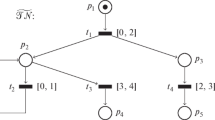Abstract
In this paper we provide both an operational and an abstract concurrent semantics for zero-safe nets under the individual token philosophy. The main feature of zero-safe nets is a primitive notion of transition synchronization. Besides ordinary places, called stable places, zero-safe nets come equipped with zero places, which are empty in any stable marking. Connected transactions represent basic atomic computations of the system between stable markings. They must satisfy two main requirements: 1) to model interacting activities which cannot be decomposed into disjoint sub-activities, and 2) not to consume stable tokens which were generated in the same transaction. Zero tokens acts as triggers for the firings of the transitions which compose the transaction. The abstract counterpart of a zero-safe net consists of a P/T net where each transition locates a distinguished transaction. In the second part of the paper, following the Petri nets are monoids approach, we make use of category theory to analyze and motivate our framework. More precisely, the operational semantics of zero-safe nets is characterized as an adjunction, and the derivation of abstract P/T nets as a coreflection.
Research supported by Office of Naval Research Contracts N00014-95-C-0225 and N00014-96-C-0114, National Science Foundation Grant CCR-9633363, and by the Information Technology Promotion Agency, Japan, as part of the Industrial Science and Technology Frontier Program “New Models for Software Architechture” sponsored by NEDO (New Energy and Industrial Technology Development Organization). Also research supported in part by U.S. Army contract DABT63-96-C-0096 (DARPA); CNR Integrated Project Metodi e Strumenti per la Progettazione e la Verifica di Sistemi Eterogenei Connessi mediante Reti di Comunicazione; and Esprit Working Groups CONFER2 and COORDINA. Research carried on in part while the second author was on leave at Computer Science Laboratory, SRI International, Menlo Park, USA, and visiting scholar at Stanford University.
Preview
Unable to display preview. Download preview PDF.
Similar content being viewed by others
References
E. Best, R. Devillers and J. Hall. The Box Calculus: A New Causal Algebra with Multi-label Communication. In Advances in Petri Nets '92, LNCS, n. 609, 21–69. Springer-Verlag, 1992.
C. Brown and D. Gurr. A Categorical Linear Framework for Petri Nets. In Proceedings of the 5th LICS Symposium, 208–218, 1990.
R. Bruni, J. Meseguer, and U. Montanari. Process and Term Tile Logic. Technical Report, SRI International, to appear.
R. Bruni and U. Montanari. Zero-Safe Nets, or Transition Synchronization Made Simple. In Proceedings of EXPRESS'97, ENTCS, Vol. 7, 1997.
P. Degano, J. Meseguer, and U. Montanari. Axiomatizing the Algebra of Net Computations and Processes. Acta Informatica, 33(7):641–667, October 1996.
P. Degano, R. De Nicola, and U. Montanari. A Distributed Operational Semantics for CCS based on Condition/Event Systems. Acta Informatica, 26:59–91, 1988.
F. Gadducci and U. Montanari. The Tile Model In: Gordon Plotkin, Colin Stirling, and Mads Tofte, Eds., Proof, Language and Interaction: Essays in Honour of Robin Milner MIT Press, to appear.
R. Gorrieri and U. Montanari. On the Implementation of Concurrent Calculi into Net Calculi: Two Case Studies TCS 141, 1-2, 1995, 195–252.
R.J. Van Glabbeek and G.D. Plotkin. Configuration Structures. In D. Kozen, editor, Proceedings of the 10th LICS Symposium, IEEE, pages 199–209, 1995.
R. Van Glabbeek and F. Vaandrager. Petri Net Models for Algebraic Theories of Concurrency. In Proc. of PARLE, LNCS, n. 259, 224–242. Springer-Verlag, 1987.
U. Goltz and W. Reisig. The Non-Sequential Behaviour of Petri Nets. Information and Computation, 57:125–147, 1983.
S. MacLane. Categories for the Working Mathematician. Springer-Verlag, 1971.
J. Meseguer and U. Montanari Petri Nets are Monoids: A New Algebraic Foundations for Net Theory. Proc. 3rd LICS Symposium, IEEE 1988:155–164.
J. Meseguer and U. Montanari. Petri Nets are Monoids. Information and Computation, 88(2):105–155, October 1990.
J. Meseguer, U. Montanari, and V. Sassone. Process versus Unfolding Semantics for Place/Transition Petri Nets. TCS, Volume 153, issue 1-2, (1996) pages 171–210.
J. Meseguer, U. Montanari, and V. Sassone. Representation Theorems for Petri Nets. Festschrift in honor of Prof. Wilfried Brauer to appear.
E.R. Olderog. Operational Petri Net Semantics for CCSP. In G. Rozenberg, editor, Advances in Petri Nets '87, LNCS, n. 266, 196–223. Springer-Verlag, 1987.
W. Reisig. Petri Nets. Springer-Verlag, 1985.
G. Ristori. Modelling Systems with Shared Resources via Petri Nets. PhD thesis TD 05/94, Department of Computer Science, University of Pisa, 1994.
V. Sassone. An Axiomatization of the Algebra of Petri Net Concatenable Processes. Theoretical Computer Science, vol. 170, n.1-2, pp 277–296, 1996.
G. Winskel. Event Structure Semantics of CCS and Related Languages. In Proceedings of ICALP '82, LNCS, n. 140, pages 561–567. Springer-Verlag, 1982.
G. Winskel. Petri Nets, Algebras, Morphisms and Compositionality. Information and Computation, 72:197–238, 1987.
Author information
Authors and Affiliations
Editor information
Rights and permissions
Copyright information
© 1998 Springer-Verlag Berlin Heidelberg
About this paper
Cite this paper
Bruni, R., Montanari, U. (1998). Zero-safe nets: The individual token approach. In: Presicce, F.P. (eds) Recent Trends in Algebraic Development Techniques. WADT 1997. Lecture Notes in Computer Science, vol 1376. Springer, Berlin, Heidelberg. https://doi.org/10.1007/3-540-64299-4_30
Download citation
DOI: https://doi.org/10.1007/3-540-64299-4_30
Published:
Publisher Name: Springer, Berlin, Heidelberg
Print ISBN: 978-3-540-64299-2
Online ISBN: 978-3-540-69719-0
eBook Packages: Springer Book Archive




